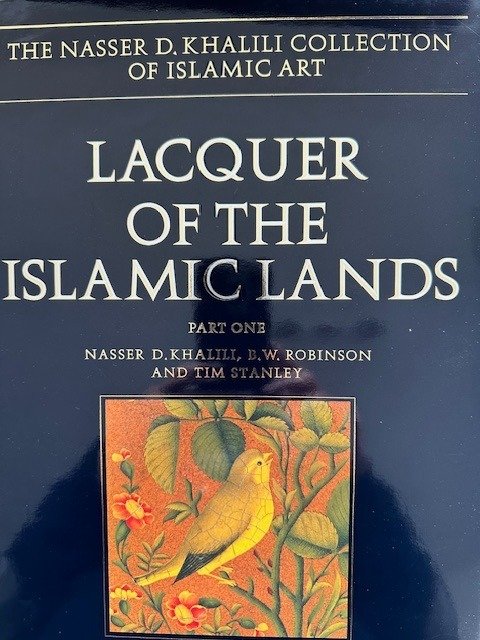
Dr. Mikhail Borisovich Piotrovsky, Oleg Yakovlevich Neverov, e.a. - The Hermitage Collections - 2010
Nro. 84784645

Nro. 84784645

Lacquer of the Islamic Lands, Parts One and Two (Nasser D Khalili Collection of Islamic Art, XXII) Nasser D Khalili, B.W.Robinson and Tim Stanley, Hardcover, 1996
Part One
Nasser D. Khalili, B.W. Robinson and Tim Stanley
1996
This two-part volume presents the Collection’s more than 500 examples of Islamic lacquer – predominantly papier-mâché wares with painted and varnished decoration – which is probably the largest holding of its kind in any single collection. The most characteristic forms are the bookbinding, the pen box, the casket and the mirror case, but the Collection contains examples of other forms, such as spectacle cases, fans, and a splendid backgammon table.
The material published in Part One offers an opportunity to follow the history of Islamic lacquer from the late 15th century onwards, in centres as far apart as Istanbul and the Muslim courts of India. At the same time, the development of the decoration, from the Chinese-influenced ornament of the early years to the Europeanizing styles of the 19th century, can be traced.
The Collection contains works by almost every known lacquer painter, including Muhammad Zaman, ‘Ali Ashraf, Muhammad Sadiq, Abu Talib al-Mudarris and Lutf ‘Ali Khan Shirazi, as well as masters celebrated for work in other media, such as Mu‘in Musavvir and Ahmad Nayrizi, and those who are previously unrecorded, such as Muhammad Amin.
Part Two concentrates on the period with which Islamic lacquer is most often associated – Iran in the Qajar period (1779–1924).
A large section of the volume is devoted to the work of the two most important workshops in Isfahan in the mid-19th century – the first is that of Najaf ‘Ali and his associates, the other that of the Imami family. Further sections cover the growth of European influence on the iconography and style of Iranian lacquer in the second half of the 19th century and, in particular, Russian lacquer made for export to Iran and its Iranian imitators. The last section is a ground-breaking study of the seals of the pen box makers.
About the author(s):
Professor Sir Nasser D. Khalili – Founder of the Khalili Collections; Honorary Fellow of the University of London; Visiting Professor, School of Oriental and African Studies, University of London
The late B.W. Robinson – Former Fellow of the British Academy; former Keeper of Metalwork, Victoria and Albert Museum, London; specialist in Islamic painting and the arts of Qajar Iran
Tim Stanley – Senior Curator, Middle Eastern collection, Victoria and Albert Museum, London; specialist in Islamic manuscript production, calligraphy and the decorative arts and has a longstanding interest in Ottoman culture
Details
In two parts. Part One: 276 pages; fully illustrated in colour and some line drawings, section for halftone enlargements of signatures; hardback with dust jacket (slipcased); 36 x 26 cm; 1996; ISBN 1-874780-62-5
Part Two: 271 pages; fully illustrated in colour; sections for pen box makers and halftone enlargements of signatures; hardback with dust jacket (slipcased);36 x 26 cm; 1997; ISBN 1-874780-63-3
Näin ostat Catawikistä
1. Löydä jotain erityistä
2. Tee korkein tarjous
3. Maksa turvallisesti